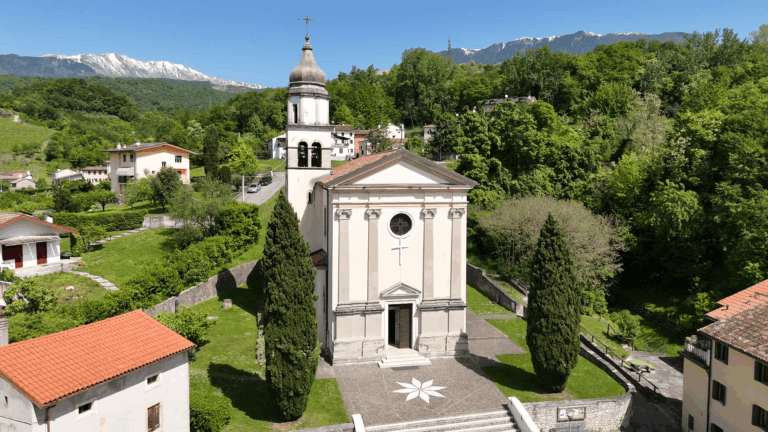ARTISTS’ ROADS
LE VIE DEGLI ARTISTI
watch the videos at the bottom of the page!
Cappella Maggiore: Anzano
Mountains. A village. A river… and sweet cherries.
A strip of meadow rich with varied botanical species.
A footpath runs snugly along the edge of a stream.
And then, a wooden bridge comes into view, climbing steeply from the riverbank before continuing horizontally. It’s supported by four sturdy posts with a crossbeam. You can make out the handrail, ending in spherical finials, and people crossing it…
And on the opposite bank? There it is: a dense forest, beyond which we glimpse the gate of a walled city. Inside, a geometric arrangement of buildings with steeply pitched, twin-sloped roofs, over which rises, isolated on the hilltop, the fortress with its quadrangular towers.
Our gaze moves onwards to the hills, the steep mountains behind, and to the right, a craggy Dolomite peak that seems dusted with the last snow.
The foreground is sharply detailed. But slowly, it fades, yielding depth to the distant landscape.
But take note: Those rooftops and that bridge aren’t drawn from life.
They reveal the painter’s knowledge of graphics and art beyond the Alps.
For along the Alemagna Road came goods, but also people, ideas, and inspiration.
In this work, painted shortly after 1525, Francesco da Milano shows himself in step with the latest in Venetian art.
The nature in the foreground, painstakingly described, recalls the Florentine tradition brought to Milan by Leonardo da Vinci. Yet as the eye moves back, it becomes sensation, atmosphere, as in the works of Giovanni Bellini, or Giorgione.
The Dolomites. the rugged Prealpine ridges, the curving lines of the hills, castles, walled towns and clear, running waters. These are constants of the landscape.
Sixteenth-century art in the Veneto is a world you can touch.
And that world makes sacred scenes feel real.
What could be more tangible than the armour of Saint Vitus? Or the cope worn by Saint Titian, a deep red velvet, patterned in fine linear embroidery? Or Saint Roch’s green stockings?
Look closer. The banner. The gloves. The bishop’s crozier…
Real saints, true portraits.
Saint Sebastian, for instance. His profile recalls a figure from the Miracle of the Reattached Foot, carved in 1525 for the Ark of Saint Anthony in Padua. It’s the work of Tullio Lombardo, a master of Venetian classicism.
The composition is crystal-clear. The pyramid structure is held together by glances and gestures. Saint Vitus looks to Mary. The Christ Child turns towards Saint Titian.
Below, in the centre, the two plague saints, Roch and Sebastian, kneel, pleading for the Virgin’s protection.
They were born a thousand years apart, but both from the same region of France, facing the Mediterranean.
Saint Roch is a pilgrim of the fifteenth century. Elegant, yet his staff bears a towel, a sign of service.
Saint Sebastian is a martyr of the early Church. He was pierced, but not defeated, by arrows.
His nakedness is not shame, but beauty of the body and soul. His powerful form embodies Salus, which is at once health, and salvation.
Between them stands a small tree connecting heaven and earth. A symbol of rebirth through faith. And behind the saint, a bare tree, stripped of life.
Mary, upon the clouds, is grace itself. At once refined, and earthly.
An angel offers the Christ Child a handful of cherries.
That succulent fruit points to the Passion. And the Child’s eager grasp hints at acceptance.
But these cherries are not red. They are yellow, a rare variety, perhaps once grown on the sunlit slopes of Anzano.
MORE EXPERIENCES!
Cerchiamo Francesco da Milano:
- nella parrocchiale di Lago.
- nell’abbazia di Follina.
- nel Duomo di Serravalle.
- nella sala dei Battuti di Conegliano.
MULTIMEDIAL MAP: “ARTISTS’ ROADS – LE VIE DEGLI ARTISTI- EN”!

